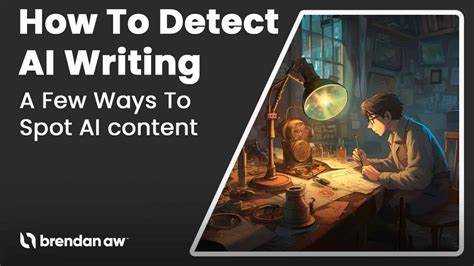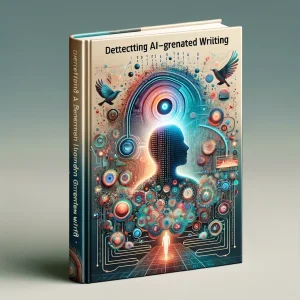How to Detect AI writing?
In the enlarge landscape of technology, it’s become more challenging to understand whether the words you’re reading were crafted by a human or generated by Artificial Intelligence. With AI become more corrupted, it’s essential to equip ourselves with the tools to identify its presence in the written word. In this guide, we’ll find into the specific signs that can help you detect AI writing.
Suppose, you’re scrolling through an article, absorbing the information, when suddenly a thought knock to you. Is this content written by a human or an Artificial intelligence? AI detectors are usually based on language models similar to those used in the AI writing tools they’re trying to detect. The language model essentially looks at the input and asks “Is this the sort of thing that I would have written?” If the answer is “yes,” it concludes that the text is probably AI-generated.

The Human Touch
Humans are inherently imperfect beings and our writing reflects that. We use idioms, common & simple sentences and sometimes, we even let our sentences run a bit wild. On the other hand, AI strives for perfection. It tends to produce content that is grammatically flawless but lacks the subtle imperfections that make human writing unique.
Take a moment to reflect on the last article you read. Did it have that human touch? Or Did it resonate with you on a personal level? If not, you might want to research on it more.
Understanding the Art of AI Writing
AI writing has come a long way and separate it from human authored content requires a sharp eye. Here are some specific signs to watch out for:
- Consistent Tone and Style
AI tends to maintain a consistent tone and style throughout a piece. Unlike humans, who may shift their writing style based on mood or context, AI algorithms often lack that nuance. So, if you notice an unwavering tone from start to finish, you might be dealing with the handiwork of artificial intelligence.
- Overuse of Buzzwords
AI has a penchant for buzzwords and jargon. If an article bombards you with an excessive number of industry-specific terms without providing clear explanations, it could be a red flag. Humans usually strive for clarity, avoiding the trap of drowning readers in a sea of technicalities.
- Unusual Structure
While AI can replicate grammatical structures, it might struggle with the more nuanced aspects of writing. Keep an eye out for oddly constructed sentences or paragraphs that seem out of place. Humans tend to maintain a flow that feels natural, while AI may inadvertently create awkward structures.
- Lack of Personal Touch
One of the key giveaways is the absence of a personal touch. Humans infuse their writing with experiences, emotions, and anecdotes. If an article reads like a robot listing facts without any personal flavor, it’s a strong indicator of AI involvement.
- Inconsistent Information
AI may stumble when it comes to fact-checking and maintaining consistency throughout an article. If you encounter conflicting information or glaring errors, it could be a sign that a machine, rather than a discerning human, crafted the content.
Emotional Intelligence
One of the greatest challenges for AI is replicating human emotions in writing. While AI can be programmed to recognize and mimic emotions, there’s still a palpable difference between genuine human expression and artificial sentiment.
Look for emotional depth in the writing. Humans infuse their words with passion, empathy, and personal experiences. If the piece you’re reading feels emotionally detached or overly clinical, it could be a red flag for AI involvement.
Inconsistencies and Redundancies
Humans are notorious for being inconsistent. We may repeat ourselves, use redundant phrases, or even contradict our own statements. AI, however, follows a strict set of rules, resulting in highly logical and consistent content.
Scan the writing for inconsistencies or repeated phrases. If you find none, it might indicate that a meticulous AI algorithm is behind the words.
Contextual Awareness
Understanding the context in which a piece of writing exists is a uniquely human trait. We incorporate personal experiences, cultural references, and current events seamlessly into our narratives. AI, while capable of mimicking context, often lacks the finesse that comes with genuine human understanding.
Pay attention to how well the content aligns with the context of the subject matter. If it seems like a machine regurgitating information without a real grasp of the topic’s nuances, AI might be at play.
Transitional Phrases and Word Choices
Humans love their transitional phrases. We use words like “however,” “in addition,” and “on the other hand” to guide readers through our thoughts. AI tends to be more direct, jumping from point to point without the grace of transitional phrases.
Look for the flow of the writing. Does it transition smoothly from one idea to the next, or does it feel like a series of disconnected statements? If it lacks the finesse of transitional phrases, an algorithm could be orchestrating the prose.
Diverse Vocabulary vs. Repetition
Humans revel in the richness of language. We have an extensive vocabulary and delight in choosing the perfect word for every occasion. AI, while capable of vast vocabulary, often falls into the trap of repetition. If you notice the same words or phrases cropping up throughout the writing, it might be a sign of artificial authorship.
Keep an eye out for the diversity of language. Humans love to spice things up with synonyms and varied expressions. If the writing feels sameness, you might be in the realm of AI-generated content.
Tools to Aid Your Detective Work
Armed with these insights, you can also enlist the help of various online tools designed to spot AI-generated content. Here are some noteworthy options:
- Content Authenticity Checkers
Several online tools specialize in analyzing the authenticity of content. They scrutinize writing patterns, language use, and stylistic elements to determine whether a piece is likely AI-generated. Keep in mind that these tools aren’t foolproof but can serve as an additional layer of scrutiny.
- Plagiarism Detectors
AI models often draw from vast datasets, leading to unintentional similarities with existing content. Plagiarism detectors can help identify content that closely resembles other published works, raising a flag if the piece is more machine than human.
- Sentiment Analysis Tools
Humans express emotions naturally in their writing. Sentiment analysis tools can detect the emotional tone of a piece, helping you discern whether the content evokes a genuine human sentiment or is merely a calculated imitation.
Putting Your Detective Skills to the Test
Now that you’ve got the tools and knowledge, let’s put your detective skills to the test. Consider the following two excerpts and see if you can spot the AI-generated content:
Quote 1: “The intricate dance of words weaves a tapestry of ideas, each sentence a carefully crafted brushstroke on the canvas of expression. As the author, I embark on a journey through the labyrinth of language, guided by the muse of creativity. Together, we sculpt a narrative that resonates with the symphony of human experience.”
Quote 2: “The use of language is like playing a game of chess. Each move, a strategic placement of words on the board of communication. It’s a dance where every step matters, and the rhythm is set by the pulse of human connection. As a writer, I navigate the linguistic chessboard, aiming to checkmate the reader’s mind with the power of words.”
Take a moment to think which excerpt feels more authentically human and which one might be the product of Artificial Intelligence.
In a world where AI is increasingly integrated into our daily lives, the ability to separate between human and artificial writing is a valuable skill. Remember, while AI can simulate many aspects of human language, it still lacks the depth, deficiency and emotional resonance that make our writing truly unique.
Detecting AI writing is an evolving challenge, but armed with an understanding of its patterns and the right tools, you can express the curtain on automated content. Remember, the magic of human expression lies in its deficiency, the quirks that make each piece of writing a unique fingerprint. So, the next time you’re reading an article, keep an eye out for the subtleties that set human creativity apart from the algorithms in the digital realm. When you’re engrossed in an article, take a moment to assess its authenticity. Is it a symphony of human expression or is it a well-orchestrated algorithmic composition? By honing your skills in detecting AI writing, you’ll navigate the digital landscape with a discerning eye, ensuring that the human touch remains an irreplaceable aspect of the written word.

